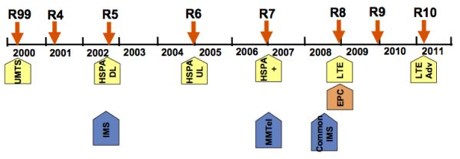
Ever since Apple unveiled iPhone 4S at the Let’s talk iPhone event earlier in the week, there has been confusion whether Apple’s new iPhone supports HSPA+ and to add to the confusion, we heard reports that Apple and AT&T are working together to change the network indicator in the status bar to “4G” with an iOS software update.
Brian Klug at AnandTech has just posted a nice article to clear the confusion.
King goes on to explain that the UMTS standards are defined by an organisation known as the 3rd Generation Partnership Project (3GPP), which is a body comprised of partners like telecommunications companies, wireless carriers, and cellular hardware manufacturers.
3GPP is responsible for formulating standards and almost every few years, it rolls out a major revision that are finalised, synchronised and which ultimately become “releases”. As you can see below, release 99 defines UMTS, release 5 defines HSDPA, 6 defines HSUPA, 7 – HSPA+, 8 – LTE, and 10 – LTE Advanced.

Brian Klug points out the main reason for the confusion is that manufacturers don’t need to include every feature from some release to say that their hardware is compatible with that release.
So in case of release 7, which defines the HSPA+ standard, it includes features such as reduced signaling, faster call setup, continuous packet connectivity, reworked RCC states (idle, DCH, FACH, e.t.c), MIMO, and higher order modulation support. On the downlink, 64QAM or MIMO gets added, and on the uplink, 16QAM gets added.
King says that even though we will find out what baseband is in iPhone 4S after it is disassembled, he is certain that Apple may have used Qualcomm “Gobi” MDM6600 wireless chip that is used in CDMA iPhone 4 or something similar.
King writes:
The specs all line up, and while that part doesn’t include 64QAM on the downlink, it does include a number of the other HSPA+ features I’ve mentioned, and is thus 3GPP Rel.7 and therefore “HSPA+.”

King goes on to add:
Actually using these higher orders of modulation requires favorable radio conditions, of course, and the result is that 64QAM on the downlink or 16QAM on the uplink only gets used in very well tuned systems or cell center. There have been some drive tests done which have shown that 64QAM only really gets used 10% of the time on average. In the iPhone 4S’ case here in the USA, it’s silly to argue about whether or not the phone can decode 64QAM if AT&T doesn’t even use it.
So there you go, iPhone 4S is indeed a HSPA+ device even though in the tech specs page, Apple states that it is compatible with HSDPA and HSUPA network.

You can also read King’s article where he talks about when HSPA+ is real 4G.
[via AnandTech]